Ertach Kernow - Minions Moor, enjoyable Cornish heritage day out
An old friend back in Cornwall last week suggested that we go on a day out to make the most of some beautiful weather. He wanted to see something of Cornwall beyond the towns and beaches where he’d been walking the past few days. I suggested a trip and walk on Minions Moor taking in a few historic monuments, the Hurlers Stone Circle, the Cheesewring and perhaps a church.
Travelling up the A30 we stopped briefly at Jamaica Inn at Bolventor. This of course now a well-known tourist destination through the writings of Daphne du Maurier was originally a 16th century coaching inn on the main north road into and through Cornwall. A small hamlet became established with its own parish church, between 1849 to 1981, carved out of the adjoining parishes of Altarnun, St Neot and Cardinham. Following closure, the church is now a Grade II listed private residence.
Taking backroads, sadly without time to visit the beautiful Golitha Falls we arrived at Minions to walk across the moors towards the Cheesewring. It always amazes me how many Cornish folk I talk too have never visited this part of Cornwall with its iconic stone structures sculpted by the winds over thousands of years. We made our way through the Hurlers Stone Circles, which legend tells us were created from young men playing hurling on the Sabbath. After the local saint sought intervention from God they were turned to stone. The legends vary in some ways, but the truth is that these date to the Neolithic or early Bronze Age.
It’s always so pleasant to see the cows and horses grazing without a worry in the world on the moorland as folk make their way towards Stowes Hill, with its wind sculpted stones on its summit. The fourth highest tor on Bodmin Moor after Bronn Wenelli (420m), Tor Garow (400m) and Kil Margh (396m) Stowe Hill has perhaps the most interesting features.
After returning we travelled to view Trethevy Quoit one of the Neolithic wonders of Cornwall, dating back some 4,500 years. Perhaps the finest of Cornish dolmens or cromlechs, Trethevy with its 20-ton capstone stands some nine feet high and would have probably been covered by a mound with an entrance. Thought to have been a ritualistic house for the dead many of these dolmens are believed to have been used continuously through the Copper Age into the Bronze Age. Trethevy well deserves a visit and is much appreciated by young people who often comment on first seeing it with ‘cool’ or the like.
The next stop was St Cleer Holy Well. This 15th century building was reconstructed, as with many holy wells, in the 19th century and is a splendid monument standing next to a 15th century wayside cross. The well had fallen into ruination by the 19th century and in 1858 the holy well, cross and surrounding land was bought by Henry Penrose of Helston. In 1864 the well was restored in memory of his grandfather John Jope a former vicar of St Cleer. This is the only example of a well house with an open porch-like design in Cornwall. It is easy to access and walk in and around to get a better view.
Off to view King Doniert’s Stone, which lies within an enclosure purchased and constructed by Liskeard Old Cornwall Society in the 1930’s. It was passed by them to the Ministry of Works, now English Heritage. The site is managed today by Cornwall Heritage Trust, along with the Hurlers Stone Circles and Trethevy Quoit. King Doniert’s and what is known as The Other Half Stone’ date from the 9th century. Doniert or Dungarth was a local Cornish ruler drowned in 875, mention of which can be found in the Annales Cambriae (The Annals of Wales), which also recorded other Celtic events. The inscription reads “Doniert Rogavit pro anima” which translates as “Doniert begs prayers for the sake of his soul”. Beneath the stones is a rock cut chamber, discovered in 1849, thought to be either early mine workings or possibly an early chapel. This enclosure with its historic monuments always looks so pretty in the spring with daffodils dotted about and surrounding the stones.
Whilst driving toward St Neot another brief stop to have a look at the historic Treverbyn Bridge. This was rebuilt in 1412 and has happily been bypassed by an adjacent road bridge helping protect it. Now on a minor road this was once a major route during medieval times, fortunately the 15th century stonework forming the majority of the bridge, remains in good condition. The Register of Bishop Stafford of Exeter mentions on 21st January 1412 ‘it carried the road from Liskeard to Bodmin over the Fowey, and being ruinous, the Bishop wrote to the Archdeacon of Cornwall, ordering collections to be made throughout the Archdeaconry, and promising an Indulgence to the Faithfull who should contribute.’ The church of course didn’t part with any money itself, but at least encouraged rebuilding the bridge, which along with the river view can be enjoyed today.
St Neot recognised for its wonderful church with its stained-glass windows also has a holy well and terrific archive facilities that put many much larger towns to shame. But firstly, to the London Inn for a bite to eat where although we had missed the lunch deadline the hospitable staff provided us with a splendid ploughman’s lunch. This is one of those comfortable traditional pubs that can still be found in many communities throughout Cornwall and still thriving, often helped by their village proactively promoting itself as a heritage site destination.
Fully sated we were off to St Neot’s Church, named after the local saint who died around 877 and was buried in the church. His remains were stolen and taken to Eynesbury, now called St Neots, in Huntingdonshire. The church was later rebuilt, rededication is mentioned as taking place in 1321, but most of the church dates from the mid-15th century although the tower dates from the 14th century. Further extensions continued up to the Reformation from the mid-1530’s when these ceased. The pre-reformation-stained glass is what St Neot’s church is perhaps best known. ‘What is most surprising is how they survived the iconoclastic window smashing, by the parliamentary forces during the English Civil war and early Commonwealth period. Preservation of St Neot’s windows may have been a combination of family connections and some thinking outside the box planning. The church made a payment of ‘1s 6d for a jornyes riding to Mr Anthony Rous to prevent the taking downe of the church windows’ to buy lime plus ‘1s to William Oliver for lyming the church glass’ in 1652/53. This covered the offending images, much hated by the Puritans, whilst allowing light into the church. This plus much restoration work over subsequent centuries provides us with the wonderful array of windows we see today.’ [Ertach Kernow – 16th Dec 2020 - Medieval Marvels Light up our Lives, available on the website]
St Neot’s is a splendid medieval church with many interesting features and monuments well worth a visit. Outside there is a Anglo-Saxon cross dating from the late 9th century purporting to have been donated to St Neot’s by King Alfred after visiting before he became king. The tower besides being a historic landmark pleasingly flies the Baner Sen Peren, Cornwall’s national flag. The flag was first mentioned by Davies Gilbert in his Parochial History of Cornwall published in 1835. Also seen there is an oak tree branch placed there every year on 29th May as part of St Neot’s annual Oak Apple Day celebrations. This date commemorates the restoration of the monarchy in 1660. Samuel Pepys recorded ‘Parliament had ordered the 29th of May, the King's birthday, to be for ever kept as a day of thanksgiving for our redemption from tyranny and the King's return to his Government, he entering London that day.’ During the period of Cromwell’s Commonwealth period no singing, dancing, theatre or any public frivolity including colourful clothing was allowed. The reign of Charles II, who became known as the Merry Monarch, ending this dour era. Each year St Neot goes to town celebrating this anniversary with a parade, period costumes, singing, dancing and lots of fun.
We then searched for St Neot’s Holy Well situated some 250 yards down a pretty tree lined lane with the River Loveny burbling along beside it. Arriving at the holy well site we traversed the boggy ground, wet feet proved not entirely successfully, to reach the small building. A large, engraved stone tells visitors it was rebuilt in 1852, but somewhat detracts from the building. A smaller unobtrusive granite stone, engraved with Restored 1996, lies in the ground outside the door. The small wooden door opens into the holy well with three steps down to the water.
Returning to the car we wended our way home, fully satisfied with our day out. Unfortunately, the light didn’t encourage a visit to Castle an Dinas with its spectacular views over the surrounding countryside, but that can wait for my friends next return and future tour around other Cornish heritage sites.
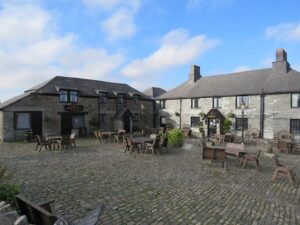


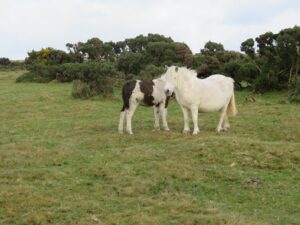
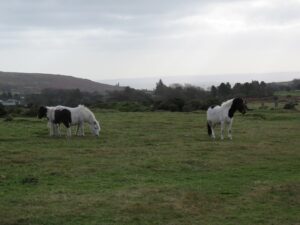
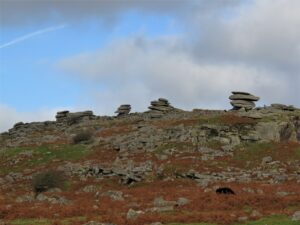
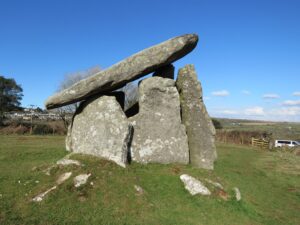
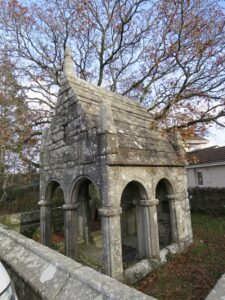
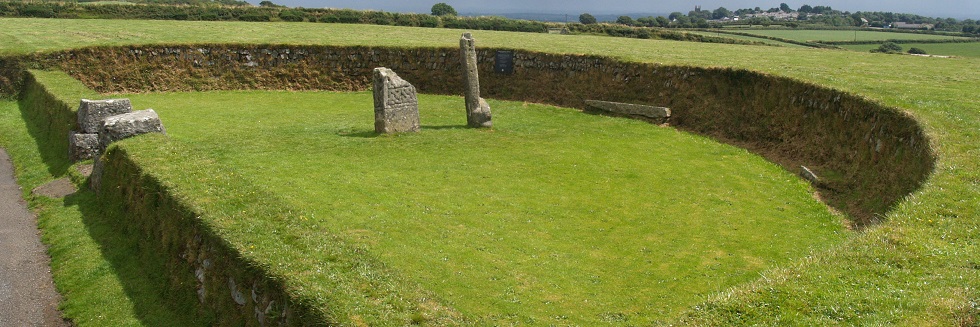
![King Doniert's & Other Half Stone's [2] King Doniert's & Other Half Stone's](https://www.cornwallheritage.com/wp-content/uploads/2021/12/King-Donierts-Other-Half-Stones-2-300x225.jpg)
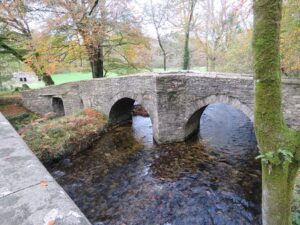
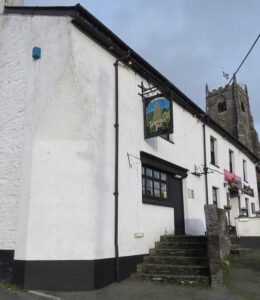
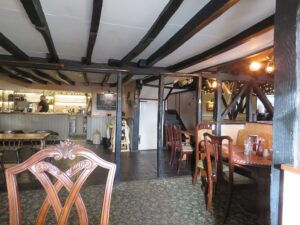
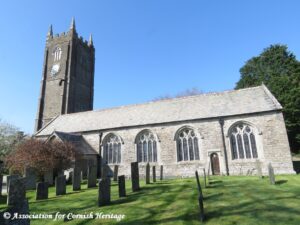
![St Neot's Church window [1] St Neot's Church window](https://www.cornwallheritage.com/wp-content/uploads/2021/12/St-Neots-Church-window-1-279x300.jpg)
![St Neot's Church window [2] St Neot's Church window](https://www.cornwallheritage.com/wp-content/uploads/2021/12/St-Neots-Church-window-2-242x300.jpg)
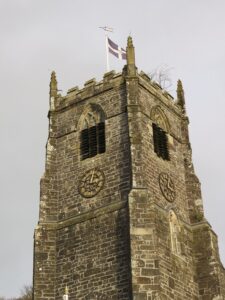
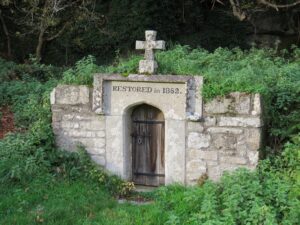
![[76] Voice - Ertach Kernow- 081221A An enjoyable heritage day out [S] Ertach Kernow- An enjoyable heritage day out](https://www.cornwallheritage.com/wp-content/uploads/2021/12/76-Voice-Ertach-Kernow-081221A-An-enjoyable-heritage-day-out-S-234x300.jpg)
![[76] Voice - Ertach Kernow- 081221B An enjoyable heritage day out [S] Ertach Kernow- An enjoyable heritage day out](https://www.cornwallheritage.com/wp-content/uploads/2021/12/76-Voice-Ertach-Kernow-081221B-An-enjoyable-heritage-day-out-S-228x300.jpg)
![[76] Ertach Kernow Heritage Column - 08 December 2021 -Students handle Cornish issues Ertach Kernow Heritage Column - 08 December 2021 -Students handle Cornish issues](https://www.cornwallheritage.com/wp-content/uploads/2021/12/76-Ertach-Kernow-Heritage-Column-08-December-2021-Students-handle-Cornish-issues-1-273x300.jpg)